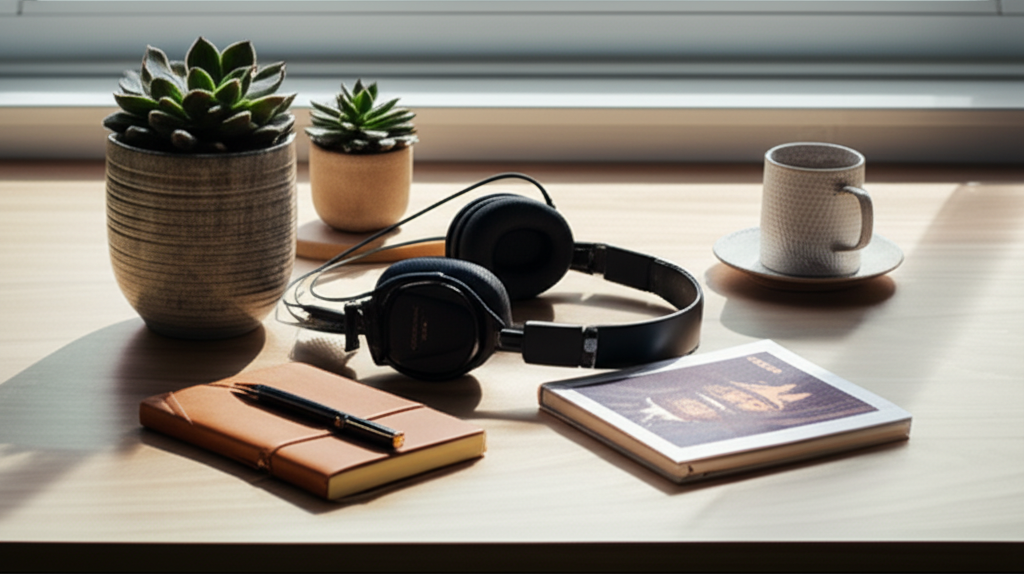Now Reading: Stress vs. Anxiety: Differences & When to Seek Help
-
01
Stress vs. Anxiety: Differences & When to Seek Help
Stress vs. Anxiety: Differences & When to Seek Help

Is It Stress or Anxiety? Unlock the Difference & Know When to Get Help
Ever found yourself feeling utterly overwhelmed, with a racing heart and a mind that just won’t quiet down? It’s so easy to label it all as “stress,” but what if what you’re truly experiencing is anxiety, or perhaps a blend of both? This confusion is incredibly common, and honestly, both stress and anxiety are very real, natural parts of our human journey.
Understanding the difference between stress and anxiety isn’t just about labels; it’s a powerful, compassionate step towards gently managing your well-being more effectively and knowing exactly when to reach for the right kind of support. In this heartfelt guide, we’ll gently unpack what each truly means, explore their overlapping symptoms, highlight their crucial distinctions, and most importantly, equip you with practical self-care strategies and clear guidance on when it’s time to seek professional help. You deserve to feel understood and empowered.
What is Stress? Your Body’s Natural Response to External Triggers
Think of stress as your body and mind’s very own natural alarm system – a physiological and psychological response to perceived demands or threats. The crucial aspect of stress is that it nearly always has an identifiable, external trigger. This could be anything from a looming work deadline, navigating financial issues, a challenging relationship problem, or adapting to major life changes like moving or a new job. It’s your body’s way of responding to a specific, demanding situation.
Typically, stress is a temporary state. Once the stressor is removed or resolved – perhaps the project is handed in, the bill is paid, or that difficult conversation is finally had – the feeling of stress tends to subside. It gracefully activates your body’s “fight-or-flight” response, releasing hormones like adrenaline and cortisol. This natural surge is actually meant to help you rise to the challenge, preparing you to either confront or navigate the situation, like a burst of energy to meet that important deadline.
What is Anxiety? Persistent Worry Beyond a Specific Threat
On the other hand, anxiety is a feeling of fear, worry, or unease that often feels more pervasive and less tied to a single, obvious external trigger. While anxiety can certainly emerge as a reaction to chronic stress, it can also manifest as a persistent state of apprehension that lingers even after a stressor is gone, or even when there’s no clear, immediate stressor at all. It often feels like it stems from an internal origin, a sense of dread or perceived danger that might not have an obvious, external cause.
A hallmark of anxiety is its deeply future-oriented nature. You might find yourself caught in a challenging cycle of excessive worry about potential future events, “what-if” scenarios, or outcomes that haven’t happened yet, and may never happen. When this persistent worry becomes overwhelming, feels disproportionate to the actual situation, and begins to significantly interfere with your daily life, it can escalate into what is known as an anxiety disorder, such as Generalized Anxiety Disorder (GAD) or even panic attacks. Please know that these are treatable conditions.
Overlapping Symptoms: The Shared Landscape of Stress and Anxiety
It’s completely understandable why these two are often confused! You’re certainly not alone in feeling this. Stress and anxiety share a significant overlap in their physical and psychological manifestations. You might experience many of these common symptoms whether you’re dealing with a demanding situation or a persistent sense of dread, making it tricky to tell them apart:
- Physical Symptoms:
- Increased heart rate or palpitations
- Rapid breathing or shortness of breath
- Muscle tension, tension headaches, or jaw clenching
- Digestive issues like nausea, stomach aches, diarrhea, or constipation
- Fatigue or feeling constantly drained
- Difficulty sleeping (insomnia) or restless, unrefreshing sleep
- Excessive sweating or dizziness
- Dry mouth
- Emotional and Mental Symptoms:
- Irritability or moodiness
- Difficulty concentrating or a “foggy” mind
- Feeling overwhelmed or constantly on edge
- Restlessness or agitation
- General unhappiness or a pervasive sense of dread
- Feeling a sense of fear without a clear, identifiable reason
Key Distinctions: How to Gently Tell the Difference
While the symptom list might seem strikingly similar, looking at the nuances can truly help you distinguish between stress and anxiety. Here’s a gentle way to break it down, focusing on their core characteristics:
- Trigger:
- Stress: Almost always has a clear, identifiable external trigger (e.g., a specific project, an upcoming event, a financial burden you’re actively addressing).
- Anxiety: Often feels more diffuse, abstract, and deeply internal. It may or may not have an obvious external trigger, or it might be a disproportionate reaction to a minor trigger. It’s more about the internal constant worry or sense of dread than the external event itself.
- Duration:
- Stress: Usually temporary. It tends to resolve once the demanding situation or external trigger is gone, managed, or you’ve adapted to it.
- Anxiety: Can be persistent and long-lasting, lingering even after a stressor has passed, or existing without any clear cause. Chronic anxiety can feel like a constant, unwelcome companion.
- Focus:
- Stress: Primarily focused on the present situation or immediate demand. Your mind is occupied with overcoming the current challenge and finding solutions.
- Anxiety: Heavily future-oriented, involving excessive worry about potential outcomes, ‘what-if’ scenarios, and things that haven’t happened yet – and may never happen.
- Severity/Impact:
- Stress: Normal levels of stress can actually be motivating, helping you focus and perform. While uncomfortable, it’s generally proportionate to the situation and can even spur growth.
- Anxiety: Can be disproportionate to the actual threat and significantly interfere with daily life, relationships, work, and overall well-being. It can lead to debilitating avoidance behaviors and profound distress, making everyday tasks feel monumental.
Stress vs. Anxiety: Real-Life Scenarios to Help You Identify What You’re Feeling
Sometimes, the best way to understand the distinction is through examples. Let’s look at a few common situations:
Scenario 1: The Big Presentation
- Stress: Imagine you have a major presentation at work next week. You feel a tightness in your chest, you’re practicing constantly, and your mind races with how to perfect your slides. You might lose some sleep in the nights leading up to it, but once the presentation is over and it goes well, you feel a huge wave of relief, and your symptoms subside. This is stress – a focused response to a clear, demanding external event with a definite end.
- Anxiety: Now, imagine you have no specific presentation, but the thought of having to present someday fills you with overwhelming dread. You constantly worry about embarrassing yourself, even if no presentation is scheduled. You might avoid opportunities at work that involve public speaking, and these feelings persist for weeks or months, even without a specific trigger. This persistent, future-oriented worry, disproportionate to an immediate threat, is indicative of anxiety.
Scenario 2: Financial Worries
- Stress: You just received an unexpected, large bill due next month. You feel a knot in your stomach, you’re budgeting carefully, and perhaps picking up extra shifts to cover it. You might feel irritable or distracted until you’ve found a solution. Once the bill is paid, the tension lifts. This is a clear case of stress – a response to a specific, identifiable financial pressure.
- Anxiety: On the other hand, perhaps your finances are stable, but you find yourself constantly worried about a hypothetical future financial crisis. You spend hours every day imagining worst-case scenarios, checking your bank account compulsively, and find it hard to enjoy anything because of this lingering dread, even though there’s no immediate threat. This disproportionate, pervasive, and non-specific financial worry points more to anxiety.
Scenario 3: Social Gatherings
- Stress: You’re hosting a large family dinner, and you’re feeling overwhelmed trying to coordinate everything, prepare the food, and clean the house. You might feel rushed and a bit frazzled, but you power through, and once everyone arrives and is settled, you start to relax and enjoy the evening. This is stress – a response to the demands of a specific social event.
- Anxiety: You’re invited to a casual gathering with friends, and the thought of it fills you with such intense dread that you make an excuse not to go. You worry for days leading up to it about what you’ll say, how others will perceive you, or if you’ll do something “wrong,” even though these are trusted friends. This persistent, disproportionate fear of social situations, leading to avoidance, often signals social anxiety.
When to Seek Professional Help: Recognizing the Signs
First and foremost, please know that seeking professional help is a profound sign of strength, courage, and proactive self-care – absolutely not a weakness. There’s truly no shame in reaching out for support when you need it most. Knowing when to seek help for anxiety or chronic stress is a crucial, compassionate step in navigating your mental health journey.
It’s time to gently consider connecting with a trusted mental health professional if you notice any of these clear indicators persistently impacting your life:
- Interference with Daily Life: Your symptoms are consistently affecting your work, school performance, meaningful relationships, social life, or your ability to engage in self-care activities you once enjoyed.
- Persistent and Excessive Worry: You experience worry that is incredibly hard to control, constant, feels overwhelming, and is disproportionate to the actual situation at hand.
- Unexplained Chronic Physical Symptoms: You have ongoing physical ailments like frequent headaches, persistent stomach issues, constant muscle tension, or chronic fatigue, with no clear medical explanation from your doctor.
- Avoidance Behaviors: You find yourself avoiding people, places, activities, or situations that trigger your fear or anxiety, causing your world to shrink.
- Duration: Your symptoms have been present and impactful for six months or more, even if they fluctuate in intensity.
- Feeling Overwhelmed or Hopeless: You feel consistently unable to cope on your own, or a pervasive sense of hopelessness about your situation and future.
- Considering Self-Harm or Suicidal Thoughts: This is a critical sign that requires immediate attention and support. If you or someone you know is having thoughts of self-harm or suicide, please reach out for help right away. You are not alone, and help is available.
- In the U.S., call or text 988 to connect with the Suicide & Crisis Lifeline.
- In the UK, call 111 (NHS) or Samaritans on 116 123.
- Search online for your local crisis line or emergency services if outside these regions – a quick search for “[Your Country] mental health crisis line” can provide immediate support.
Don’t hesitate to talk to your primary care physician first; they can often offer initial guidance or provide compassionate referrals. Other helpful professionals include compassionate therapists (such as those practicing Cognitive Behavioral Therapy – CBT or specializing in psychotherapy), experienced psychologists, or dedicated psychiatrists (who can prescribe medication if necessary and appropriate). Treatment options often include talk therapy (like CBT), medication, or a combination of both. Finding the right fit for you and your unique journey is key to effective anxiety relief and sustainable stress management.
Accessible Self-Care Strategies for Stress and Mild Anxiety
While professional help is truly vital when needed, there are also many practical, empathetic, and evidence-based self-care strategies for stress and mild anxiety that you can lovingly adopt into your daily life. These aren’t meant to replace professional support, but they can significantly help you manage everyday mental health challenges, foster resilience, and gently enhance your overall well-being. These techniques are wonderfully beneficial for both stress and mild anxiety:
- Embrace Physical Activity: Even a 10-minute mindful walk outdoors can make a surprisingly big difference. Regular, enjoyable exercise releases endorphins, your body’s natural mood boosters. The key is to find an activity you genuinely enjoy and that feels good for your body – movement is medicine!
- Nourish Your Body with a Healthy Diet & Hydration: Aim for balanced, regular meals and snacks throughout the day. Be mindful of excessive caffeine and alcohol, as they can sometimes exacerbate feelings of anxiety and disrupt your precious sleep.
- Prioritize Restful Sleep: Establish a consistent sleep schedule, even on weekends, to regulate your body’s natural rhythms. Create a relaxing, soothing bedtime routine and ensure your sleep environment is dark, quiet, and cool – your mind and body heal during sleep.
- Practice Mindfulness & Deep Breathing: Simple breathing exercises (like calming box breathing or 4-7-8 breath) can instantly soothe your nervous system. Explore free apps offering guided meditations that can gently help you practice mindfulness, bringing your awareness back to the present moment.
- Set Kind Boundaries & Learn to Say No: Protecting your precious time and energy is not selfish; it’s crucial self-care. Learn to gently decline commitments that overextend you or don’t align with your well-being. This is a powerful act of self-respect.
- Connect with Your Support System: Reach out to trusted friends, family, or a supportive community. Sharing your worries can lighten the load significantly and remind you that you’re truly not alone in your feelings.
- Engage in Hobbies & Joyful Activities: Intentionally schedule time for activities you genuinely love and that bring you joy – whether it’s reading a good book, expressing yourself through painting, getting lost in music, or connecting with nature through gardening. These deliberate breaks are vital for mental restoration and sparking joy.
- Explore Journaling: Putting your thoughts and feelings onto paper can be incredibly cathartic and a wonderful way to process complex emotions. It helps you identify patterns, gain new perspectives, and simply let go of what’s swirling in your mind.
- Spend Time in Nature: Connecting with green spaces or simply observing the beauty of nature can significantly reduce stress and promote a profound sense of calm. Even looking out a window at trees or listening to birdsong can offer a moment of peace.
Embracing Your Emotional Landscape with Kindness
In wrapping up our journey together, remember that understanding the nuanced difference between stress and anxiety isn’t about labeling yourself; it’s about empowering yourself to respond more effectively and compassionately to your unique emotional landscape. Both stress and anxiety are normal, albeit sometimes challenging, human experiences. Yet, recognizing their distinct characteristics – their triggers, duration, and focus – can be a profound guide, leading you toward the most supportive path for your healing and growth.
You are strong for exploring these feelings, and please remember to approach yourself with endless kindness and deep self-compassion. It’s truly okay not to be okay sometimes, and it takes immense bravery to explore what you’re genuinely feeling. Know that proactive self-care strategies are powerful tools for your everyday well-being, and seeking professional support is an equally powerful, commendable act for building resilience and enhancing your overall mental health – absolutely free from any shame or judgment.
Your Next Steps Towards Well-being:
If you’ve read through this guide and are still unsure about what you’re experiencing, or if your feelings of stress or anxiety are persistently overwhelming and interfering with your daily life, please don’t hesitate for a moment to reach out to a trusted professional. They are there to help you navigate these waters with expertise and care.
- Reflect: Take a moment to gently reflect on the distinctions and scenarios we discussed. Do any resonate strongly with your current experiences?
- Practice Self-Care: Choose one or two self-care strategies from our list that feel most accessible and try integrating them into your routine this week. Small steps make a big difference!
- Seek Support: If your symptoms are persistent, overwhelming, or impacting your daily life significantly, remember that reaching out to a mental health professional is a courageous and wise step. Your primary care physician can be a great first point of contact for referrals.
- Explore More: Continue your journey of self-discovery and well-being. You can find more supportive resources right here on our blog, designed to help you thrive.
You are not alone on this path, and with understanding, self-compassion, and the right support, you can absolutely cultivate a more peaceful and resilient life. We are here cheering you on.




















